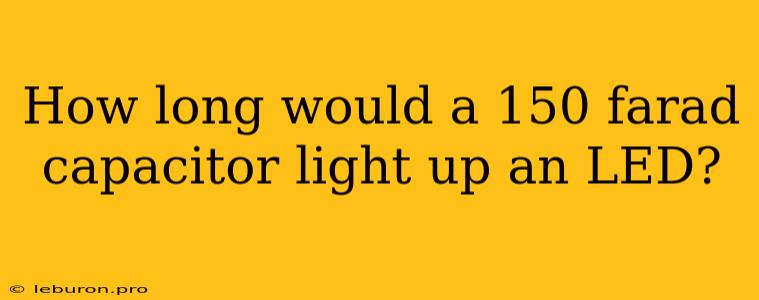The lifespan of an LED powered by a 150 Farad capacitor depends on several factors, including the LED's power consumption, the capacitor's voltage, and the desired brightness. While a 150 Farad capacitor can store a considerable amount of energy, it's not a direct replacement for a power source like a battery. This article will delve into the intricacies of calculating the duration an LED would be illuminated by a 150 Farad capacitor, considering various parameters and providing practical insights.
Understanding the Basics: Capacitance, Voltage, and Energy Storage
Capacitors are electronic components designed to store electrical energy in an electric field. Their ability to store charge is measured in Farads (F), with higher Farad values indicating greater storage capacity. The amount of energy stored in a capacitor is directly proportional to its capacitance and the square of the voltage across it.
Energy Stored in a Capacitor
The energy stored in a capacitor is calculated using the following formula:
Energy (E) = 1/2 * C * V^2
Where:
- E = Energy (measured in Joules)
- C = Capacitance (measured in Farads)
- V = Voltage (measured in Volts)
LED Power Consumption
LEDs consume power, measured in Watts (W). The power consumption of an LED is determined by its forward voltage (Vf) and forward current (If).
Power (P) = Vf * If
The Relationship Between Energy Storage and LED Power
The duration an LED can be illuminated by a capacitor is determined by the ratio of the energy stored in the capacitor to the LED's power consumption.
Duration (t) = Energy (E) / Power (P)
Calculating the Lifespan of an LED
To determine the lifespan of an LED powered by a 150 Farad capacitor, we need to consider specific parameters. Let's take an example:
- Capacitance (C): 150 Farads
- Voltage (V): 5 Volts
- LED forward voltage (Vf): 3.3 Volts
- LED forward current (If): 20 milliamperes (mA)
Calculating the Energy Stored in the Capacitor
Using the energy storage formula, we can calculate the energy stored in the capacitor:
E = 1/2 * 150 F * (5 V)^2 = 1875 Joules
Calculating the LED's Power Consumption
Using the power consumption formula, we can calculate the LED's power consumption:
P = 3.3 V * 20 mA = 66 milliwatts (mW) = 0.066 Watts
Calculating the Lifespan of the LED
Using the duration formula, we can calculate the lifespan of the LED:
t = 1875 J / 0.066 W ≈ 28409 seconds ≈ 7.9 hours
This calculation suggests that a 150 Farad capacitor charged to 5 Volts can power a 3.3V, 20mA LED for approximately 7.9 hours. However, this is a theoretical calculation, and actual performance may vary due to several factors.
Factors Affecting Lifespan
The lifespan of an LED powered by a capacitor can be influenced by various factors:
- Capacitor discharge rate: Capacitors discharge over time, causing the voltage across the LED to decrease. This can affect the LED's brightness and potentially shorten its lifespan.
- LED efficiency: Different LEDs have varying efficiencies. Higher efficiency LEDs will consume less power and therefore last longer.
- Ambient temperature: Higher temperatures can affect the capacitor's performance and the LED's efficiency.
- Voltage drop: As the capacitor discharges, the voltage across the LED drops. If the voltage drops below the LED's minimum operating voltage, the LED will cease to function.
Conclusion
A 150 Farad capacitor can provide a considerable amount of energy to power an LED. However, it's crucial to understand the factors that influence the lifespan of the LED, including the capacitor's discharge rate, the LED's efficiency, and the ambient temperature. The duration an LED is powered by a capacitor is directly related to the capacitor's energy storage capacity and the LED's power consumption. By considering these factors, you can estimate the lifespan of an LED powered by a 150 Farad capacitor and make informed decisions about its application.
